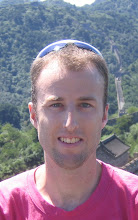I live in a two-bedroom apartment on the fourth floor just inside one of the western gates of the ancient city wall. My bedroom overlooks a park where speakers play music and a fountain in a man-made lake runs and throughout the day, making it sound as if it were raining nonstop during daylight hours.
Nanjing Normal University is about a 20-minute walk to the north and the center of the downtown where I teach is a 30-minute walk to the east.
I brought two books back here with me focus on different parts of Nanjing's modern history. One is The Rape of Nanking by Iris Chang, about the Japanese invasion of the city in 1937 and the atrocities committed under their rein through 1945. Nanjing (written as Nanking then) at that time was the capital of the Nationalist governed Republic of China, until the Nationalist officials and military fled and relocated the government to Chongqing (Chungking then). It was a capital for brief periods of time during several dynasties, blessed with fertile farmland in the Yangtze River valley and naturally protected by the winding river on to sides and mountains on the other. As Chang describes it:
"For centuries, water and mountain provided not only beauty for Nanjing but military protection. The Yangtze River to the west and the Purple mountain to the east shielded the city “like a coiling dragon and a crouching tiger,” to borrow an ancient phrase describing Nanjing’s natural strength."
Animals are often used in Chinese idioms, and the phrase “where tigers crouch and dragons coil” can describe a place with forbidden terrain. A similar phrase, “hidden dragon, crouching tiger” describes individuals who conceal their talents; the same phrase was reversed and used for the title of an Oscar-winning Ang Lee movie. My apartment, believe it or not, happens to be on the corner of Crouching Tiger Street (虎踞路)and Coiling Dragon Street (龙蟠路), with the address being 38 Crouching Tiger Street.
The other book that is largely set in Nanjing is Chinese Lessons by John Pomfret, a journalist with the Washington Post who was one of the first American students to study in Nanjing in the early 1980s. Universities fully reopened after the Cultural Revolution in the late 1970s and the U.S. and China normalized diplomatic relations in 1979. Pomfret’s summary of Nanjing’s history:
“Nanjing, the name means “southern capital,” is a city where Chinese traditionally went to lick their wounds while barbarians from the north carved up their country. In medieval times, it served as the capital during six short-lived dynasties when northern China was occupied by nomadic tribes from beyond the Great Wall. Nanjing was also the capital at the beginning of the Ming Dynasty in the fourteenth century and then again during the two decades preceding the Communist Revolution.”
A crossroads for plunderers and poets, emperors and colonialists, Nanjing was a safe house for Chinese culture, home to great painters and writers and the sing-song girls who worked the flower boats and brothels that lined the Qinhuai River snaking through the city… Throughout the centuries, Nanjing has been pillaged, burned, rebuilt, forgotten, and rebuilt again. In the fourteenth century, the first Ming ruler emptied the city of its citizens, exiling more than three hundred thousand to the far corners of the empire. A hundred years later, a repopulated Nanjing was celebrated as one of the most beautiful cities on earth. In the 1920s, an American architect laid plans to rebuild the city as a modern capital, a melding of Washington, D.C., and Paris, France. First, Japanese aggression in the late 1930s and then the Communist Revolution put an end to that.”
His experiences as a student in Nanjing in the early 1980s are pretty wild. Many of his classmates were either poor peasants or were children of urban middle class families who were forced to spend years in the countryside during the Cultural Revolution. Some were not able to finish high school because of the social turmoil at the time and one student lost his parents, both professors at Nanjing Normal University, when they were accused of being "rightists" and beaten to death by teenage "Red Guards" in the university's mall. Things improved after the Cultural Revolution ended upon Mao's death, but life as a student was still tough at that time. Many goods like sugar, meat and bicycles were rationed, dancing was banned on campus, and students were assigned jobs from a government planning committee upon graduation. Needless to say, it is fascinating to read about Nanjing 30 years ago and ponder how dramatically it has changed.
Subscribe to:
Post Comments (Atom)



1 comment:
great post, Sam
Post a Comment